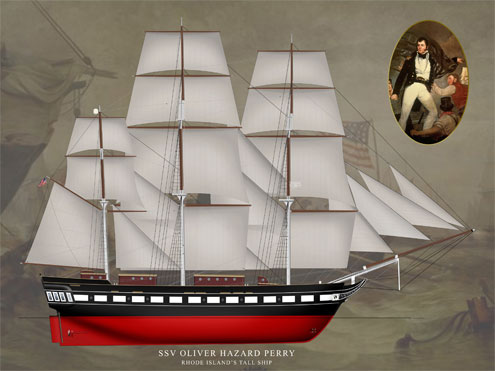Work continues in Rhode Island on completing the sail training and education vessel Oliver Hazard Perry. The hull and the deck houses are largely completed. One of the big jobs remaining, however, involves the masts for this full-rigged ship. True to the age of sail, Perry will have masts made of multiple elements: lowers, middle sections and topmasts. Until roughly the mid-nineteenth century, ships used wooden spars for ther masts. In the last days of the age of sail, both the hulls and the masts of commercial sailing vessels were built of metal, first iron and then steel. Perry's hull is steel and its lower masts are steel. The midsections and top masts, however, will be made of wood.
One important reason for this is the simple lack of know-how among steel fabricators. As OHP captain Richard Bailey says, "No one knows how to make a hollow tapered steel spar." The other reason is expense, steel mast spars would be costly — partly because the company that made the spars would be learning on the job!
An alternative is to build the mid and topmasts from wood. These are big timbers, however, requiring a massive lathe to turn them down to the proper size. Luckily, just such a lathe exists in the Spar Shop at Grays Harbor Historical Seaport in Aberdeen, Wash. The lathe, which can handle masts as large as 40 inches in diameter and 122 feet in length, has been used to build mast sections for a variety of traditional craft. Equipped with this device, the mast spars for Perry can be accurately constructed. "The giant spar lathe is surgically accurate," Bailey said. "It's just a fabulous machine."
Having been the longtime captain of the ship "HMS" Rose, a reproduction of a colonial era British frigate used for the film Master and Commander, Bailey is thoroughly familiar with wooden spars. "It's going to be a lot easier to deal with a wooden rig," Bailey said.
You can experience the excitement of sailing a full-rigged ship yourself while learning navigation and seamanship on one of Ocean Navigator's coming offshore expeditions aboard Oliver Hazard Perry. Watch for announcements of trip details coming in 2014.
An interesting sidelight to the wooden mast spars is the historical accuracy they afford Bailey in dealing with heavy weather. In the age of wooden sailing ships, vessels caught in extreme conditions would often disassemble their rig from the top to reduce windage. The topmasts would be de-rigged, lowered to the deck and lashed there. The middle sections of masts could also have their standing rigging removed and lowered so they were parallel with the lower masts. The result was a ship with only lower mast sections still standing.
Luckily, this is only a theoretical possibility. Weather information is light years better than in the 1700s, of course, and Oliver Hazard Perry is highly unlikely to ever be in a situation where such steps are necessary.


